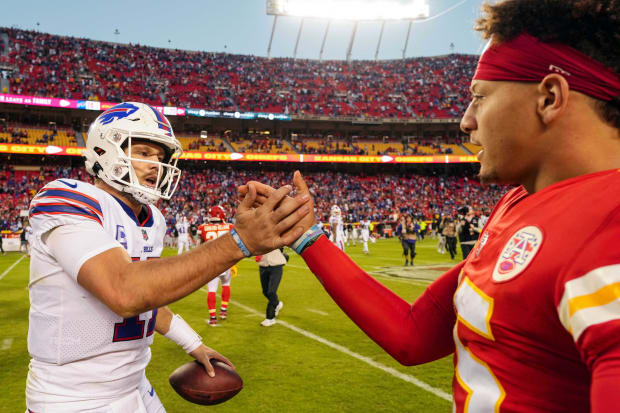The fantasy football regular season may be over, but that doesn’t mean you have to stop playing! If you’ve never played in a postseason fantasy league before, now is the perfect time to start. There are countless ways to play, ranging from salary-cap options to traditional snake drafts and best balls. Whether you set up your own league on a site like fantasypostseason.com or you join in a bigger contest such as NFC, you’re going to find the postseason can be just as much fun as the regular season.
One of the more interesting parts about postseason fantasy play is that it involves some amount of gut feeling about which teams will advance in the NFL playoffs and make it all the way to the Super Bowl. When setting your rosters no matter what format, you’ll always want to consider how to get the most out of your players based on how far you think they will advance during the postseason. It adds an element of betting to the traditional fantasy league, giving it an interesting twist. Trust me, you’ll love it!
Though there are endless ways to play, here are three common ways to play if you’re looking to get started.

Jay Biggerstaff/USA Today Sports
Best Ball Format
This is the easiest way to play if you’ve never played fantasy postseason before and you’re looking for an easy way to be invested in the playoffs. In this format, there is no limit to how many people can play in a league. It could be two or it could be 50! No draft, no timer. All each league-member does is set a lineup that lasts for the entire postseason. The catch? You can only roster one player from each team. Once that team is eliminated, that player is also eliminated from your lineup. My suggested lineup for this format is 2 QB, 3RB, 3WR, 2TE, 2 RB/WR/TE, 1K, 1DST.
Strategy-wise, you can see why you’ll want to build your roster around the teams you think will advance. For example, if you think the Chiefs will go all the way, you may want Patrick Mahomes as one of your QBs, however that means you cannot use Travis Kelce. If you want to use Travis Kelce and get a positional advantage at a thin position, maybe you roster Jalen Hurts at QB, as the Eagles are the current NFC favorites for the Super Bowl; however bear in mind that also means you can’t use A.J. Brown or Dallas Goedert.
Oh, and one more thing to think about. Both Mahomes and Hurts have a first-round bye, meaning if they happen to get eliminated in the divisional round, you could still end up with only one week of stats from them. In that case, maybe it’s better to consider someone like Brock Purdy, who will play in more games – if he makes it all the way to the Super Bowl.
See how fun this can be?
One and Done
The one and done format provides that you can only use a player once over the course of the postseason.
In this format there is no limit to how many players from each team you can roster in any given week. However, once they are used in a lineup, you cannot use them again for the remainder of the postseason. You’ll want to try to grab max points each week and not leave any on the table while still leaving yourself plenty of players available for the Super Bowl. It’s a delicate balance, as you also don’t want to avoid using a stud player only to see their team get upset in an early round.
For example, if you use Josh Allen in the wild-card round, you cannot use him again for the rest of the postseason. Instead, the following week, you could use Jalen Hurts for your divisional matchup. However, if you play Allen and Hurts in the first two rounds, what happens if it’s Bills-Eagles in the Super Bowl? You’d be stuck with Gardner Minshew! In this case, I like to play players I think will be eliminated early for my initial lineup. For example, if you don’t think the Seahawks will go very far, you may choose to play Ken Walker and Tyler Lockett in the first round.
You’ll also want to look at matchups and see if you can predict future matchups in order to make the strongest starts each week. For example, the Seahawks have been notoriously bad vs. the run this season. In that case, you may choose to play Christian McCaffrey or even Eli Mitchell in the wild-card round over Walker, despite the fact you think his team could be eliminated.
Player Multipliers
In this format, you can replace players as they are eliminated from the playoffs with other available players, however, the players that remain in your lineup and were not eliminated receive a multiplier on their points scored. For example, if you start Dak Prescott and Chris Godwin in the wild-card round and the Cowboys beat the Bucs, Prescott remains locked in your lineup but will accrue double points for the divisional matchup. Godwin could then be replaced by CeeDee Lamb in the divisional round, with Lamb only accruing that week’s stats with no multiplier. Should the Cowboys advance to the NFC title game, Prescott will gain triple the points and CeeDee will accrue double for that round. Should the Cowboys get eliminated, you can replace both the QB and WR with players from a team still alive in the playoffs, but the multiplier count would start over. You can also mix up this format by requiring the wild-card lineup to only have one player from each playoff team, after which you can add one player from each team per round as you need to make replacements.
I hope this intro to postseason fantasy leagues was helpful. Whether you play for money or bragging rights, you’re guaranteed to have a lot of fun.








